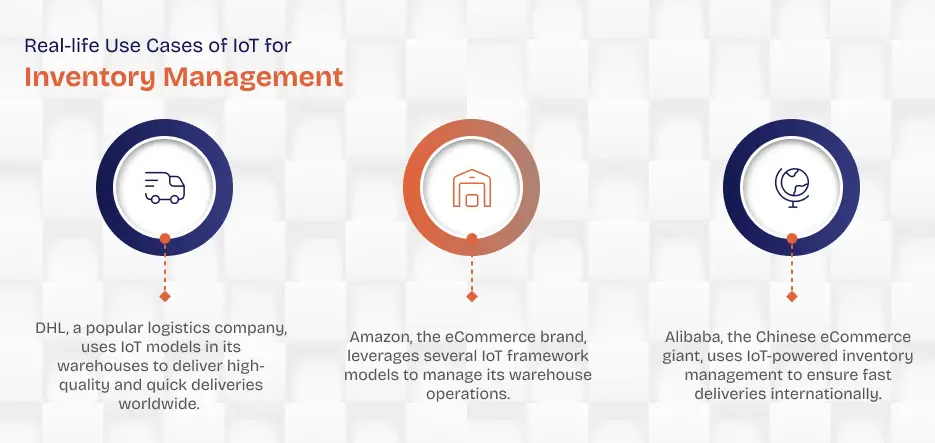With the increasing use of technology in almost every sector, the time-consumption is being cut down greatly. Similar is the case with Inventory management. The old-school methods associated with the same resulted in huge time consumption and data inaccuracy. However, things have changed with the integration of IoT in inventory management. With IoT, businesses can get real-time stats and alter their inventory based on the same.
For those unaware, IoT, or the Internet of Things is a network of interconnected devices and sensors that gather and exchange data across the Internet. The technology can be used in inventory management to provide real-time data to the manufacturers related to location, condition, movement, and inventory levels. That being said, multiple research papers in the same direction, like from the Aberdeen Group, have proved that businesses using IoT-powered frameworks witnessed around a 15% reduction in the costs of inventory.
Importance of Efficient Inventory Management
Inventory management is one of the most basic aspects that cannot be neglected in a product-based firm. Here we have mentioned the primary reasons that will throw light on the importance of inventory management for any company.
- Winning a customer base: Customers are more inclined towards the businesses that provide them with products as and when they need them. Furthermore, these customers also return to the brand in the future, along with being loyal to them. This can prove advantageous for the brands that are into launching new products now and then.
- Dominating the competition: Let’s say you have a new product in line and the customers are ordering it on a large scale. Now, smart inventory management here can ensure that you already have the product stacked for multiple customers and they can also return to you in the future for new purchases. This will also help you in making a trustworthy image in the global and local markets.
- Providing attractive discounts: Smart management of inventory will allow you to save a lot of cost that can be further used to provide the products at a discount to the customers which will attract a lot of them in no time.

Current Trends & Key Stats for IoT in Inventory Management
Many reports across the web suggest that most of the supply chain firms in the global top 25 list use tech like predictive analysis and IoT to manage inventory. Let’s have a look at a few other key statistics related to key stats in IoT in inventory management:
- Market research claims that the inventory management software market will skyrocket at a <strong>CAGR of 6.60% from USD 1.50 billion in the year 2021 to a whopping USD 2.50 billion by the year 2029.
- Many sources also suggest that the number of IoT devices will increase from USD 9.7 billion in 2020 to USD 29 billion by 2030.
All in all, the market of IoT in warehouse management is forecasted to grow at a pace of 13.5% from USD 12 billion in 2023 to USD 28 billion by 2030. Apart from that, research also suggests that the optimization of Inventory management IoT use cases will be highest during the mentioned period.
Top use cases of IoT in inventory management
Real-Time Inventory Tracking
It’s considered among the top use cases of IoT in inventory management as it helps in getting real-time stats of their inventory in transit or at the warehouse. For example, let’s say some products are en route, with IoT, you can get the exact location along with reasons behind any and every hiccup faced in the transfer. Moreover, the use of IoT diminishes communication gaps and improves customer service. You will be able to tell your customers exactly where a particular product is and how much time it will take to reach them.
Automated Re-ordering
Automated Re-ordering is another of the most popular use cases of IoT in inventory management. It makes sure that no customer has to see the not-in-stock message for the products your company is selling even after the product is available in some warehouse. For example, when the inventory levels of a product reach a point where the re-order is set, then IoT will automatically generate a re-order request so that the product can be stacked for the upcoming customers in the future based on the frequency witnessed in the past.
Asset Tracking and Management
Asset tracking and management offers information that can be useful for zero hiccups in the whole processor. First things first, IoT in inventory management helps in monitoring inventory levels in real-time which will reduce stockouts. In addition, you can also track the location of assets both indoors and outdoors along with assessing the condition of the assets which will further result in the identification and eradication of the pain points.
Cold Chain Monitoring
Cold chain monitoring allows manufacturers to attach IoT sensors to inventory for tracking location, temperature, humidity, movement, and other parameters that can have any kind of effect on the inventory. Not only this, but Radio frequency Identification or RFID along with cloud-based GPS allows micro-tracking via IoT in Inventory management. The benefits of using RFID tags are a decrease in the number of elements that cause delay, marking of the most important packages, exact information of time of arrival, location, traffic, etc.
Predictive Analytics for Demand Forecasting
IoT-powered frameworks also generate data automatically along with giving a boost of predictive analytics. Now, this data can be used to find out the problems being faced in a particular warehouse and remove them for maximum performance. IoT sensors placed in the inventory or products play a major role in the same. Record maintenance becomes very easy with the inclusion of IoT and relying on predictive analytics for products.
Enhanced Order Fulfillment
Among the most innovative use cases of IoT in inventory management is data-driven order fulfillment. Because you will already know everything about the available resources in your inventory along with increasing the efficiency of the supply chain. For example, let’s say a product is getting sold at a much higher rate than what the company expected. Now, before it goes out of stock, IoT will raise a replenishment request which will provide a window to the company so that they can maintain the stock again and the customers can get the product without facing any hassle of getting disappointed.
Inventory Visibility in Multi-Warehouse Operations
Smart inventory management requires a lot of things and one of them is inventory visibility in multi-warehouse operations. The same allows the company to monitor the location, quantity, and movement of an inventory in real-time. This results in better decision-making related to inventory planning, and order fulfillment, along with reducing costs incurred in maintaining inventory and achieving better customer satisfaction at the end of the day.
Inventory Accuracy and Error Reduction
IoT in inventory management has done one of the best things which is providing accuracy to the company related to data and management. The IoT-based systems reduce the need for human intervention in the data and errors as well. With real-time data inaction, companies can get the exact data insights along with maintaining the inventory levels, being cost-efficient, avoiding stockouts, etc. To understand with an example, a basic level scan of the inventory with a smartphone app can fetch the exact condition of an inventory. Furthermore, it also slashes down error rates by 50% along with cutting down the order fulfillment time to half.

Integration with Supply Chain Systems
Understanding the use cases of IoT in inventory management can help in the integration of supply chain systems in multiple ways. First things first, it reduces the stress related to tracking the inventory apart from monitoring and automation of the actions that are required to protect the inventory. In addition, the high-ups or the management team can see the data collected via IoT to plan for situations like the inventory getting stuck in weather, accidents, or even traffic.
Loss Prevention and Security
IoT-driven frameworks also allow companies to get real-time data that helps reduce the losses incurred because of unused inventory. It further helps in monitoring and identifying the need for maintenance of malfunctioning equipment in operation. With the help of all the data, better plans can be laid out and proper planning and strategizing will decrease the losses faced by a firm in inventory management.
IoT for Expiration Date Tracking
It never leaves a good impression on the customers when they receive an expired item. IoT in inventory management lets the company track the expiration date of the products and remove the ones that are not in good shops and are not fit for the end user. This not only helps in keeping a good hold over your inventory but also makes sure that the consumer is getting products in usable condition. This works best for companies that deal in products related to the food and beverages industry.
Automated Inventory Audits
Traditional inventory audit practices that involve human intervention always leave a scope of error that could prove fatal in the long run. Several studies highlight the use cases of IoT in inventory management, where IoT-based inventory audits allow managers to monitor data that is crucial for inventory management. Apart from that, these audits also help in stocking, monitoring, and creating goodwill for the organization in front of the customers.
Smart Shelf Monitoring
Smart shelves come packed with intelligent sensors that are built to detect the movement of goods. These sensors also track the levels of inventory and look after the replenishment. Furthermore, they also offer seamless integration with IoT thus resulting in lightning-fast data transfers and allowing the managers to take crucial decisions without any delay. Apart from that, the sensors also collect data that is useful in real-time. Companies can also use the smart shelf to integrate the same with CRM and POS-based retail systems.
Condition Monitoring of Sensitive Goods
Condition monitoring, which allows companies to collect data on various conditions affecting the quality of the goods, is a notable mention among use cases of IoT in inventory management. One of the most important ones is temperature monitoring as most of the goods are impacted by that. Further, we cannot sleep on cargo condition monitoring that gathers information based on temperature, humidity, shock, and GPS location. You can also get warning messages with IoT related to any disturbances that are encountered in inventory transfer.
Smart Packaging with IoT Sensors
Smart packaging uses IoT sensors that share information related to the condition of the product. This increases the safety of the products by giving the company the ability to monitor the humidity and temperature. In addition, smart packaging including NFC tags or QR codes can offer customer details related to the product along with promotions going on at the current time. It also helps in supply chain optimization by giving data on transit routes and storage conditions.
Predictive Stock Reallocation
Predictive relocation strategies are considered an ideal example among the use cases of IoT in inventory management. It can also help companies in predictive stock reallocation using IoT sensors to keep a check on spoilage, stockouts, and other conditions in real time. Furthermore, the historical inventory data can be used to analyze the demand along with smart shelves and more. And keeping a check on the stock levels in any inventory as soon as a certain lower point is reached will always make sure that the customers don’t have to get out-of-stock messages.
Dynamic Inventory Pricing
Dynamic inventory pricing strategies with IoT are really helpful. For example, the cost saving via IoT in Inventory management can help companies offer instant discounts to customers on products that are in demand which will further attract more consumers. Moreover, data collection on the inventory level can also help in managing item movements, and data-driven decisions, and improve supply chain performance. In addition, you can also minimize the energy consumption.
Automated Pallet Tracking
IoT frameworks are also useful for automated pallet tracking. For example, IoT-based pallets can be monitored in real-time, which gives the liberty of managing and predicting the time of a product’s arrival. Moreover, companies can also get alerts related to temperature, battery life, and other necessary elements. Multiple pallet tracking systems like Bluetooth low energy, ultra-wideband, and RFID are some of the use cases of IoT in inventory management.
Smart Bin management
Smart bin management is a tech that utilizes sensors and other smart devices to track the inventory in real time. The same helps in providing companies with stock-out notifications when a product is on the verge of getting out of stock. It also helps in placing automated reorders and managing the inventory levels based on the storage space available. Smart bin management also reduces the operational costs for a company which gives them a window to provide the products at discounted prices to the customers.
Energy Efficiency in Warehouses
Energy efficiency in Warehouses is one of the use cases of IoT in inventory management that allows companies to leverage renewable energy sources like solar or wind power. More items like daylight sensors are used in warehouses that turn off or dim the lights based on the amount of natural light reaching the warehouse premises. In addition, the automated guided vehicles used in warehouses can transport materials in a warehouse without human intervention.
Top benefits of adopting IoT in inventory management
- Cost saving: Use of IoT in inventory management helps companies address the problems that are causing product damage. These identified issues can be removed to save costs as well.
- Enhanced Efficiency: With IoT handling all the stuff related to predictive analytics and data monitoring, product managers can focus on eradicating the identified problems and making their products better.
- Better demand forecasting: IoT models also monitor the historical data and help the management teams in forecasting the demand for a particular product which will decrease the instances of overproduction or under-stocking.
- Increased visibility: IoT helps in providing better visibility of the location and condition of products en route with which the companies can provide accurate information to their consumers and warehouses related to the estimated time of arrival for a batch of products.
- Improved Inventory accuracy: It can be said that the integration of IoT boosts smart inventory management because it allows companies to measure the data related to a product’s shelf life, conditions, and location, accurately.

What are the challenges of Implementing IoT in Inventory management?
-
The high initial cost of implementation
Implementing IoT in inventory management for the first time could come at a decent cost and the companies need to plan their budget wisely for the same. For example, you can avoid purchasing IoT sensors that are of no use for the products that your company is producing. Still, a major chunk of investment will go into staff training, understanding the software, and hiring new resources if required for the same.
IoT devices produce large amounts of data and most of the information is sensitive and requires strong protection from distrustful sources. So, despite the IoT benefits in inventory management, securing systems used by companies emerges as a major challenge while implementing the same. Firms must ensure that they encrypt data transmission and storage, preventing access by unauthorized sources. Moreover, companies might have to possibly invest in hiring cyber security specialists for all the work related to data security.
-
Data Management and Analytics
-
Regular maintenance and reliability
IoT-based models also need regular maintenance of the systems and a check for any vulnerabilities that can be exploited by hackers. Without regular maintenance, a company’s sensitive data related to its inventory can be at risk of breach. In addition, the reliability of IoT systems increases a lot after integration. This means that if the system is down or lacks maintenance, then it affects the whole operation.
Conclusion
The integration of IoT has more benefits than challenges in inventory management. The only thing that you need to look at as a company is the initial expenses. Planning out these expenses in a strategic manner while keeping maintenance in mind will make the Internet of Things inventory management a force to reckon with. Connect with the leading IoT application development company to stay ahead of the demand.
FAQ
How can you use IoT devices to improve inventory accuracy?
IoT inventory management devices like smart shelves can be used to keep inventory accuracy in check as they send automated alerts whenever the inventory is on the brink of getting out of stock. Not only this but the devices also help in initiating automated replenishment of products so that the customer gets what they want without any delay.
What are the crucial things to consider before implementing IoT in inventory management?
One of the most important things to look after while implementing IoT in inventory management is the initial cost. If the initial cost is kept in control, then most likely, the integration will not feel like a pain. However, we cannot just rule out the possibility of getting new hires and staff training expenses for the same.
How does IoT help reduce costs in inventory management?
With the Internet of Things in inventory management, you can address the issues that are causing damage to the products and remove them as soon as possible along with streamlining the whole process. This will not only reduce the costs of inventory management but also help give the company a window to offer discounts on products to end users.
What are the future trends of IoT in inventory management?
In the future, we can see blockchain making a way in inventory management for better transparency and security of the data and goods. Automation on a considerable level has already been introduced with IoT in inventory management and we will see further automation in the processes as well.





![How to Make Health & Fitness Apps Like Fitbit? [2025 Guide]](https://www.a3logics.com/wp-content/uploads/2024/04/How-to-Make-Health-Fitness-Apps-Like-Fitbit.webp)



